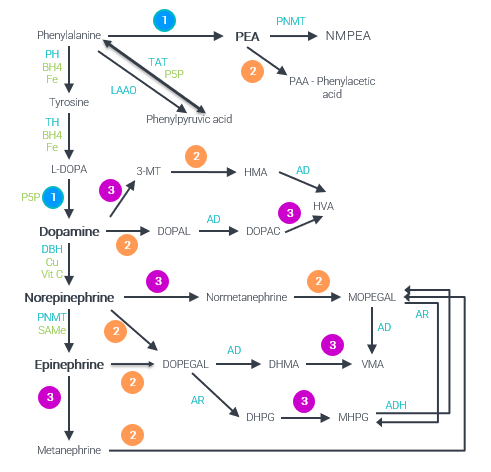Dopamine is a neurotransmitter that activates the brain’s reward center during pleasurable activities. Optimal dopamine function is involved in many aspects of health, including memory, movement, motivation, mood, attention, sleep, arousal, learning, and lactation.
What is Dopamine and How Does It Work?
Dopamine is a neurotransmitter (a chemical messenger) that is produced in large concentrations during pleasurable activities such as when eating sugar or junk food, having sex, or participating in fun and enjoyable down-time activities like spending time in nature or engaging in a favorite hobby. Dopamine is released during these times as a reward for engaging in the activities necessary for survival and reproduction such as eating, drinking, and competing.
Dopamine can act as an inhibitory neurotransmitter, which blocks a signal, or it can act as an neurotransmitter, which stimulates a signal. Whether dopamine acts as an inhibitory or excitatory neurotransmitter depends on which types of receptors are present on its target, which might be a neuron, another cell, tissue, or organ.
Dopamine helps people remember pleasurable experiences. Thus, dopamine plays a role in cravings for food, drugs, and nicotine in susceptible individuals. The sharp increase in dopamine that occurs when using some recreational drugs reinforces the brain to remember the experience and all the routines and cues associated with drug use. An example of this is the urge to smoke while driving or after lunch.
Dopamine is one of three catecholamines (including norepinephrine and epinephrine), neurotransmitters that can function as hormones and are involved in the fight-or-flight stress response. Although norepinephrine has garnered the lion’s share of attention in regards to the stress response, dopamine also plays a role in how the body responds to stress and it can influence the hypothalamic-pituitary-adrenal (HPA) axis.1,2 Acute stress generally leads to activation of the dopamine system followed by a subsequent decrease in dopamine that can lead to feelings of unhappiness.1 Researchers find a significant association between everyday stress and cravings for various substances (e.g. cocaine and amphetamine), which activate the dopamine system.1
How is Dopamine Made?
As a monoamine neurotransmitter, dopamine contains one amino group connected to an aromatic ring by a two-carbon chain. Like all monoamines, dopamine is derived from aromatic amino acids, specifically the biochemical conversion of phenylalanine to tyrosine to dopamine in a series of steps (see Figure). Dopamine is then converted to other monoamine neurotransmitters, norepinephrine and then epinephrine. Vitamin B6, iron, niacin, and tetrahydrobiopterin are the nutrient cofactors needed to make dopamine.
 Catecholamine Pathway. Dopamine, norepinephrine, and epinephrine are synthesized in the catecholamine pathway. Phenylalanine is the precursor amino acid for the catecholamines. In a series of biochemical steps, phenylalanine is converted to tyrosine, L-DOPA, dopamine, norepinephrine, and finally epinephrine. Cofactors work with enzymes to synthesize the neurotransmitters and break them down. These include tetrahydrobiopterin (BH4), iron, copper, vitamin C, vitamin B6, magnesium, and s-adenosylmethionine (SAMe).
Catecholamine Pathway. Dopamine, norepinephrine, and epinephrine are synthesized in the catecholamine pathway. Phenylalanine is the precursor amino acid for the catecholamines. In a series of biochemical steps, phenylalanine is converted to tyrosine, L-DOPA, dopamine, norepinephrine, and finally epinephrine. Cofactors work with enzymes to synthesize the neurotransmitters and break them down. These include tetrahydrobiopterin (BH4), iron, copper, vitamin C, vitamin B6, magnesium, and s-adenosylmethionine (SAMe).
Enzymes and Cofactors found in Multiple Monoamine Pathways 1) Aromatic L-amino acid decarboxylase (AADC) + Vitamin B6 2) Monoamine oxidase (MAO) + Vitamin B2 3) Catechol-O-Methyltransferase (COMT) + Magnesium + S-adenosylmethionine (SAMe) Neurotransmitters and Metabolites DHPG: 3,4-dihydroxyphenylglycol, DHMA: 3,4-dihydroxymandelic acid, DOPAC: 3,4-dihydroxyphenylacetic acid, DOPAL: 3,4-dihydroxyphenylacetaldehyde, DOPEGAL: 3,4-dihydroxyphenylglycolaldehyde, HMA: 4-hydroxy-3-methoxyphenylacetaldehyde / homovanillin, HVA: homovanillic acid, MHPG: 3-methoxy-4-hydroxyphenylglycol (aka MOPEG), MOPEGAL: 3-methoxy-4-hydroxyphenylglycolaldehyde, NMPEA: N-Methylphenethylamine, VMA: vanillylmandelic acid, 3-MT: 3-methoxytyramine, Enzymes AD: aldehyde dehydrogenase, ADH: alcohol dehydrogenase, AR: aldehyde reductase, DBH: Dopamine Beta-Hydroxylase, LAAO: L-amino-acid oxidase, PH: alanine Hydroxylase, PNMT: phenylethanolamine N-methyltransferase, TAT: Tyrosine aminotransferase, TH: Tyrosine hydroxylase, Cofactors BH4: Tetrahydrobiopterin, Fe: Iron, SAMe: S-adenosylmethionine, Vit: Vitamin
Where Is Dopamine Found in The Body?
Dopamine is made in the adrenal glands, where it modulates aldosterone and serves as a precursor to norepinephrine.3 It is most famously produced in the CNS in the midbrain, where it is made in the ventral tegmental area and substantia nigra pars compacta.4 Neurons from these areas give origin to three main pathways, the nigrostriatal, the mesolimbocortical, and the tuberoinfundibular. As central dopamine does not cross the blood-brain barrier, peripheral dopamine is minimal but does circulate in the blood stream where it affects blood flow as a vasodilator.19 Dopamine receptors are found in the kidneys, pancreas, lungs, and blood vessels outside of the central nervous system.5 In fact, renal dopamine regulates sodium extraction and electrolyte balance, and renal dopamine production or dopamine receptor function may support healthy blood pressure.5
What does Dopamine do in the Body?
Dopamine is involved in memory, movement, motivation, mood, attention, sleep, arousal, and learning. It plays a role in the stress response. Dopamine is critical to both the ability to learn and motivation.6 This is a complicated biological process as target cells must be able to differentiate whether increased dopamine is a signal to learn or move.6
In addition to its role in cognition, dopamine has a number of important physiological actions elsewhere in the body. These include:3,7
- Assisting with removal of sodium and urine from the body.
- At low concentration, relaxing blood vessels.
- At high levels, constricting the blood vessels.
- Protecting the gastrointestinal lining.
- Slowing gastrointestinal motility.
- Supporting healthy lymphocyte activity.
- Supporting heathy insulin production in the pancreas.
What Happens when Dopamine is Out of Balance?
When dopamine levels are balanced, emotions are more stable. Balanced dopamine leads to a sense of well-being and motivation, alertness, and focus. Conversely, dopamine deficiency can lead to feelings of sadness, lack of concentration, and lack of motivation. Both high and low levels of dopamine can lead to problems in the body.
Low dopamine is linked to:8-11
- Cravings
- Inability to concentrate or focus
- Lack of motivation
- Low sex drive
- Memory loss
- Mood swings
- Muscle control
- Tiredness
- Unhappy feelings
High dopamine levels are associated with:3,11
- Cravings
- Aggressiveness
- Delusions
- Difficulty controlling impulses
- Euphoria
- Extra energy
- Weight gain
- Intense sex drive
- Problems sleeping
Healthy dopamine levels also support neuromotor coordination and movement.
How does Dopamine Become Imbalanced?
A number of factors can cause dopamine deficiency or excess. These include: 12-15,16
- Stress
- Not getting enough sleep
- Deficiency of certain vitamins and amino acids (see supplement section below)
- Mutations in the COMT or MOA-B genes can interfere with dopamine metabolism
- Methylation problems
- Leaky gut
- Infections with the bacterium Clostridia can lead to dopamine excess
Furthermore, recreational drug use can alter the brain’s reward system by damaging dopamine receptors. As a person uses more and more of a recreational drug, the brain’s reward center becomes less sensitive to the point that only the drug is strong enough to elicit enough dopamine to generate a pleasurable response. Previously pleasurable experiences don’t release enough dopamine for a reward response any longer. Therefore, users have to take more just to get the same response.
How does Dopamine Interact with Other Hormones?
Dopamine works together with other catecholamines. Optimal dopamine levels are required for the production of norepinephrine, as dopamine is a precursor of this catecholamine. Sex and stress hormones can also interact with dopamine. For example, testosterone, estrogen, and cortisol each impact dopamine neurotransmission in the brains of adolescents and adults and this interaction can therefore affect psychiatric health.17 Low dopamine levels can increase prolactin. Dopamine promotes growth hormone and reduces thyroid stimulating hormone. Insulin resistance, or high insulin levels, can increase dopamine levels.
Testing for Dopamine Levels
Dopamine testing can be accurately achieved through urinary neurotransmitter testing using NeuroLab®, which is an excellent clinical tool for identifying dopamine deficiency and excess as well as imbalances in other neurotransmitters. Utilizing the gold standard in urinary neurotransmitter testing, NeuroLab® employs UHPLC Triple Quadrupole Mass Spectrometry (MS) technology in order to provide the highest level of sensitivity and specificity for testing neurotransmitters. Major universities and research facilities throughout the world continue to use this technology for measuring neurotransmitter levels in patients with a variety of mental health conditions.
How to Test Dopamine Levels at Home
Using a urinary neurotransmitter test from NeuroLab® makes it possible to test for dopamine and other neurotransmitters without the need for a blood draw. Neurotransmitter testing kits can be shipped to the patient’s home, bypassing the need for a trip to the clinic, and they can collect the urine sample in the comfort of their own home.
How Can We Naturally Support Dopamine?
Dopamine Supplements
Amino acid supplements are an option for people who want to support their dopamine levels. The amino acids phenylalanine and tyrosine are used by the body to make dopamine.* In addition, L-theanine, an amino acid derived from green tea, may increase dopamine levels in the brain.* Mucuna pruriens, known also as velvet bean, is a direct source of L-dopa and can be used supplementally to support healthy dopamine levels.*
Nutritional supplements containing vitamins and minerals can help to balance levels of dopamine.* The vitamin or mineral cofactors needed to make and remove dopamine from the nervous system include:
- Copper*
- Iron*
- Magnesium*
- SAMe*
- Tetrahydrobiopterin*
- Vitamin B2 (riboflavin)*
- Vitamin B3 (niacin)*
- Vitamin B6*
- Vitamin C*
Vitamin D may promote the health of dopaminergic neurons and support optimum dopamine levels.*18
Foods and Dopamine
Eating foods that boost dopamine levels is another strategy. These foods include:
- Almonds
- Apples
- Avocadoes
- Bananas
- Beets
- Chicken
- Chocolate
- Fava beans
- Green leafy vegetables
- Green tea
- Lima beans
- Oatmeal
- Oranges
- Peas
- Pumpkin seeds
- Sesame
- Tomatoes
- Turmeric
- Watermelon
- Wheat germ
Lifestyle
Enjoyable and relaxing activities can raise dopamine levels. These types of activities include:
- Exercise
- Massage
- Meditation
- Participating in a favorite hobby
- Playing with a pet
- Reading a book
- Walking in nature
- Yoga
References
- Belujon P, Grace AA. Proc Biol Sci. 2015;282(1805).
- Feenstra MG, Kalsbeek A, et al. Brain Res. 1992;596(1-2):169-182.
- Cleveland Clinic. Published 2022. https://my.clevelandclinic.org/health/articles/22581-dopamine.
- Ranjbar-Slamloo Y, Fazlali Z. Front Mol Neurosci. 2019;12:334.
- Drozak J, Bryła J. Postepy Hig Med Dosw (Online). 2005;59:405-420.
- Berke JD. Nat Neurosci. 2018;21(6):787-793.
- Strell C, Sievers A, et al. BMC Immunol. 2009;10:62.
- Belujon P, Grace AA. Int J Neuropsychopharmacol. 2017;20(12):1036-1046.
- Cleveland Clinic. Published 2022. https://my.clevelandclinic.org/health/articles/22588-dopamine-deficiency.
- Nieoullon A, Coquerel A. Curr Opin Neurol. 2003;16 Suppl 2:S3-9.
- Published 2016. https://www.hilarispublisher.com/open-access/dopamine-receptors-functions-synthesis-pathways-locations-andmental-disorders-review-of-literatures-2471-271X-1000120.pdf.
- Dodiya HB, Forsyth CB, et al. Neurobiol Dis. 2020;135:104352.
- ScienceDaily. Published 2008. https://www.sciencedaily.com/releases/2008/08/080819213033.htm.
- Salonen A, de Vos WM, et al. Microbiology (Reading, England). 2010;156(Pt 11):3205-3215.
- Debost JC, Debost M, et al. Acta Psychiatr Scand. 2017;136(1):85-95.
- Shaw W. Integr Med (Encinitas). 2017;16(1):50-57.
- Sinclair D, Purves-Tyson TD, et al. Psychopharmacology (Berl). 2014;231(8):1581-1599.
- Trinko JR, Land BB, et al. eNeuro. 2016;3(2).
- Missale C, Nash SR , et al. Physiological Reviews.1998;78(1):189-225. Https://journals.physiology.org/doi/full/10.1152/physrev.1998.78.1.189?rfr_dat=cr_pub++0pubmed&url_ver=Z39.88-2003&rfr_id=ori%3Arid%3Acrossref.org


